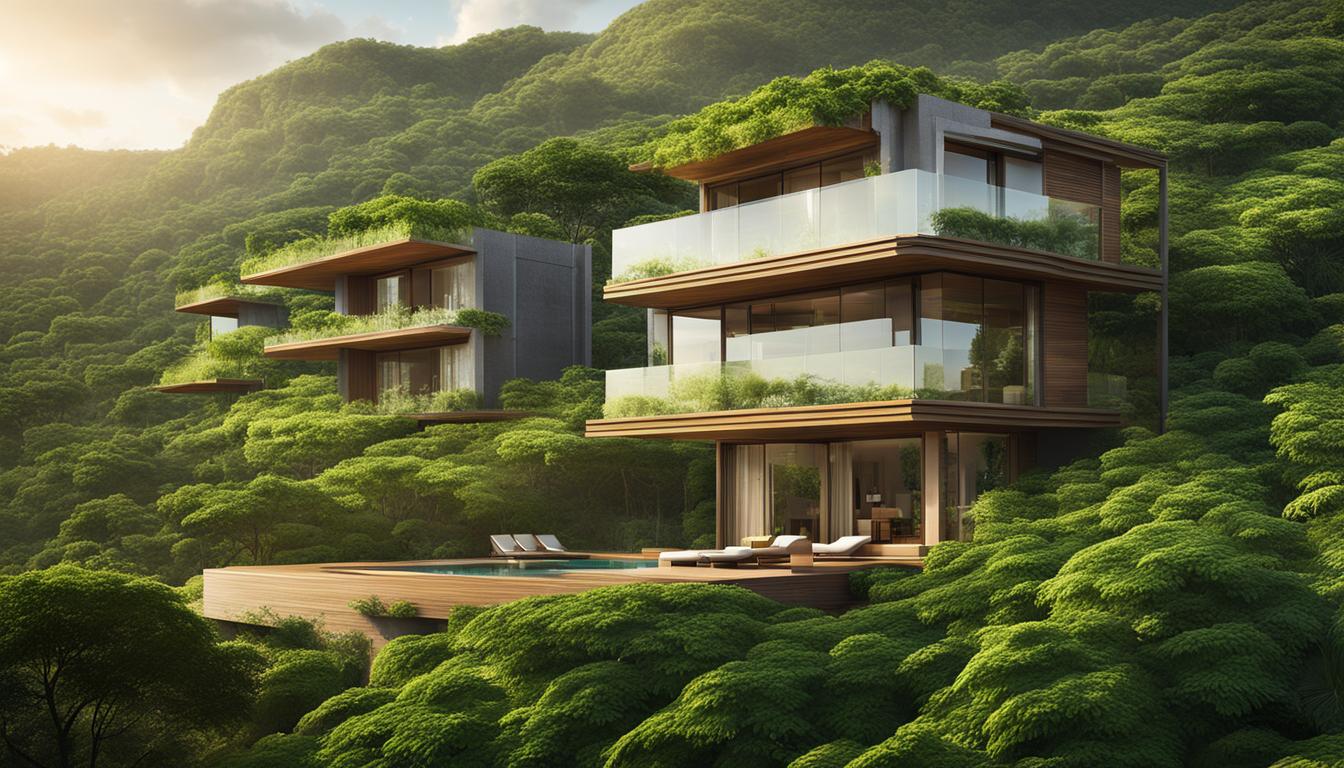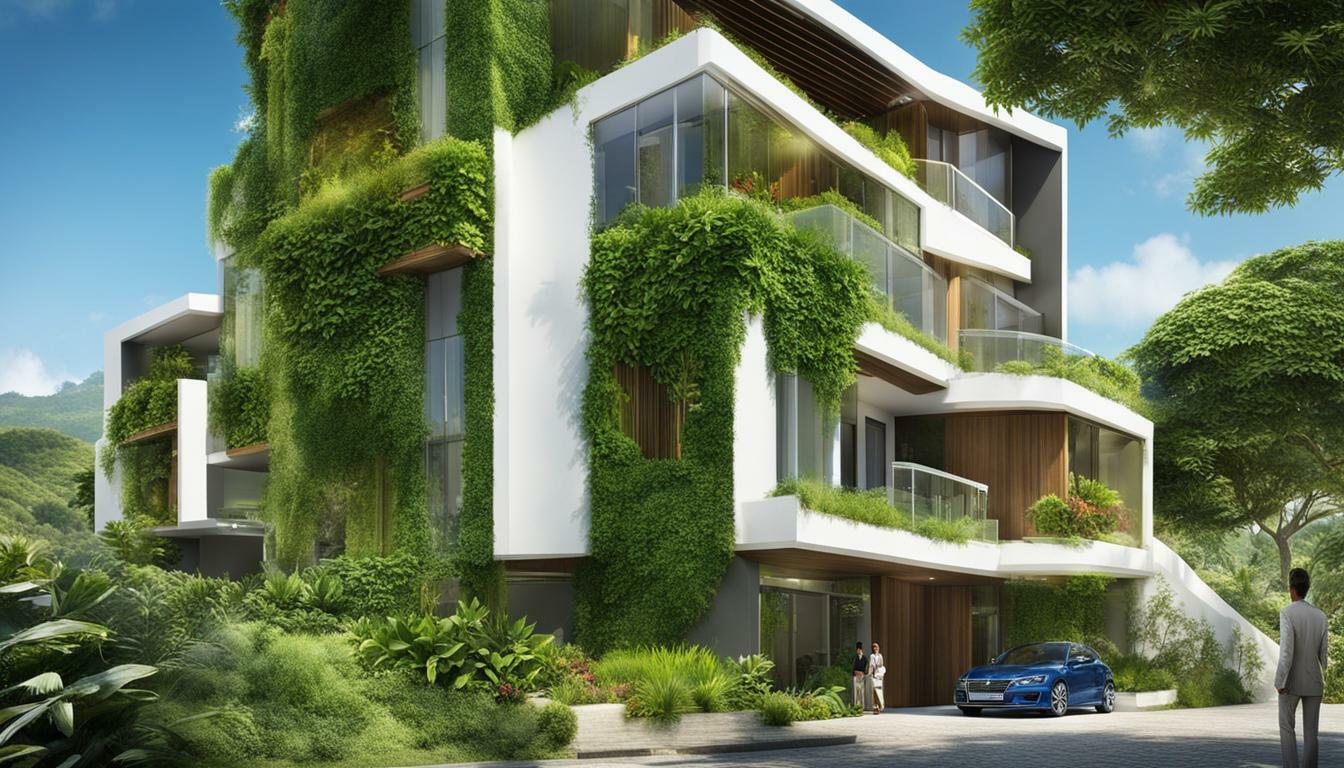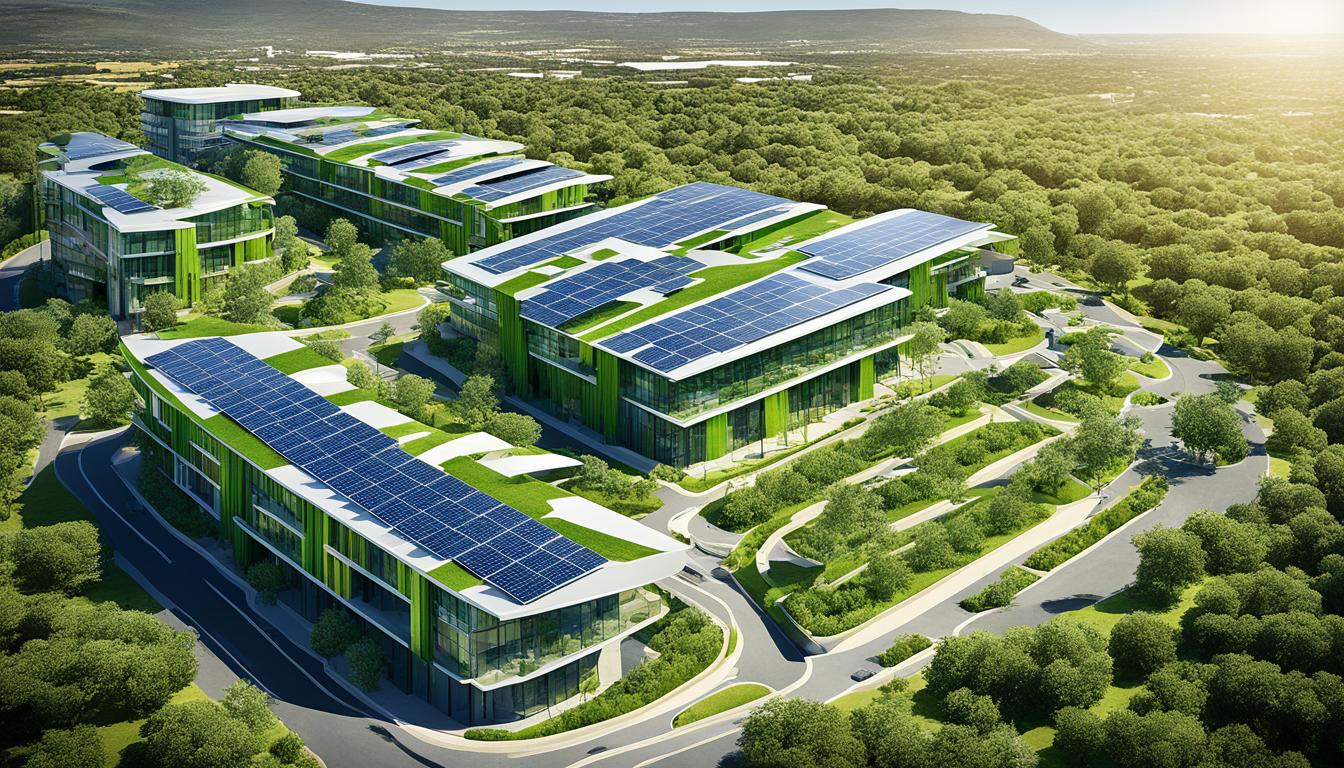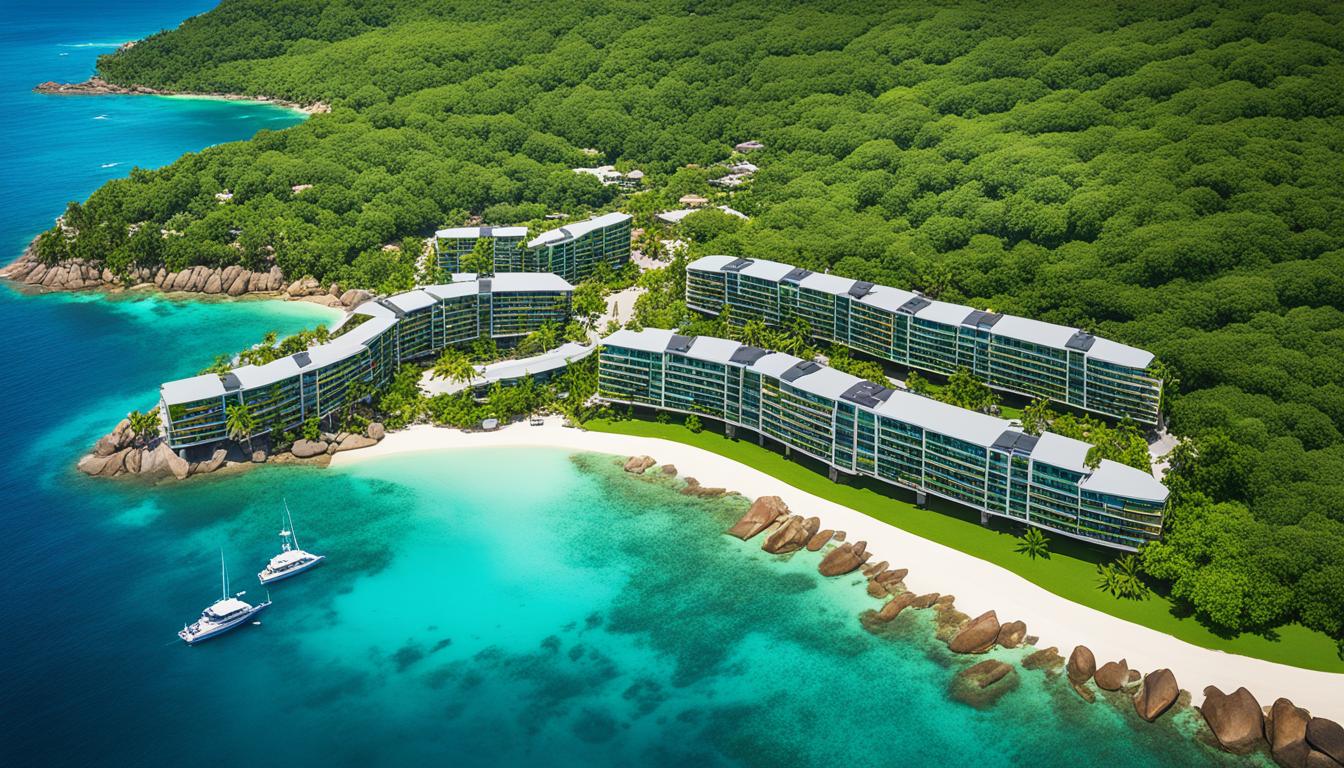Namibia’s Top Green Buildings
Welcome to our article on Namibia’s top green buildings. In this piece, we will explore the sustainable architecture of Namibia and the eco-friendly buildings that have shaped its landscape. From innovative green building design to the use of sustainable materials, Namibia has made impressive strides towards creating a more environmentally conscious future.
Key Takeaways:
- Nedbank Namibia’s green head office is the first building in Namibia to receive a six-star rating for its sustainable design.
- The building incorporates energy-saving technologies such as solar panels and rainwater harvesting systems.
- Nedbank’s commitment to sustainability extends to using eco-friendly building materials, such as fly ash and sustainable steel.
- The building’s design reduces its environmental impact through features like double-glazed windows and LED lighting.
- The recognition of Nedbank’s green head office sets a benchmark for sustainable development and inspires future eco-conscious architecture in Namibia.
Energy-Efficient Design and Construction
Nedbank Namibia’s sustainable approach to design and construction extends beyond just incorporating green building materials. The Nedbank campus in Windhoek was designed with a highly efficient approach to technological energy consumption. By utilizing energy-saving solutions such as solar panels and rainwater harvesting systems, the building reduces its reliance on traditional energy sources and minimizes its carbon footprint. These energy-efficient features not only contribute to the building’s green credentials but also result in long-term cost savings and environmental benefits.
Furthermore, the Nedbank campus in Windhoek achieved green building certification, a testament to its commitment to sustainable development and environmental responsibility. Green building certification validates that a building meets specific sustainability criteria, including energy efficiency, water conservation, indoor environmental quality, and materials selection. Through this certification, Nedbank demonstrates its dedication to creating spaces that promote a healthier and more sustainable built environment.
One of the key benefits of energy-efficient construction is its positive impact on sustainable development in Namibia. By prioritizing eco-friendly building practices and using green building materials, Nedbank has set an example for other businesses and developers in the country. The adoption of energy-efficient design and construction methods not only reduces the environmental impact of buildings but also contributes to the overall sustainability of the built environment in Namibia. This emphasis on sustainable development ensures a greener and more environmentally conscious future for the country.
| Benefits of Energy-Efficient Design and Construction | Examples |
|---|---|
| Reduced energy consumption and cost savings | Installation of solar panels and energy-efficient lighting |
| Lower carbon footprint | Use of rainwater harvesting systems and sustainable materials |
| Improved indoor environmental quality | Integration of natural ventilation and low VOC materials |
| Enhanced occupant comfort and well-being | Implementation of thermal insulation and daylighting strategies |
The energy-efficient design and construction of the Nedbank campus in Windhoek not only showcases the bank’s commitment to sustainability but also serves as an inspiration for future developments in Namibia. By prioritizing energy efficiency, utilizing green building materials, and achieving green building certification, Nedbank demonstrates that it is possible to create buildings that are both environmentally responsible and economically viable. This commitment to sustainable development sets a benchmark for the industry and encourages others to adopt greener building practices, ultimately contributing to a more sustainable future for Namibia.
Sustainable Building Materials
Nedbank Namibia’s green head office in Windhoek is not only a symbol of sustainable design but also a showcase of innovative and eco-friendly building materials. By incorporating green building materials into the construction, the bank has demonstrated its commitment to sustainable development in Namibia.
One notable example is the use of 92% strengthening steel in the building’s structure. This high percentage of sustainable steel reduces the environmental impact associated with traditional steel production and contributes to the overall sustainability of the project.
Another sustainable material used in the building is fly ash, which replaces 47% of the Portland cement. Fly ash is a byproduct of coal combustion and is known for its low carbon footprint. By utilizing fly ash, Nedbank’s head office reduces the demand for Portland cement, a material responsible for significant carbon emissions during production.
The incorporation of these environmentally conscious materials in the construction of Nedbank Namibia’s head office sets an example for other developers and businesses in Namibia. By adopting green building materials, future projects can contribute to sustainable development and minimize their environmental impact.

Sustainable Building Materials in Nedbank’s Head Office
| Material | Percentage Used | Environmental Benefits |
|---|---|---|
| Strengthening Steel | 92% | Reduces environmental impact associated with traditional steel production |
| Fly Ash | 47% substitution for Portland cement | Low carbon footprint and reduced demand for carbon-intensive Portland cement |
As shown in the table, the construction of Nedbank Namibia’s head office prioritized the use of sustainable building materials. The high percentage of strengthening steel and the substitution of fly ash for Portland cement highlight the bank’s commitment to minimizing the environmental impact of its building. By utilizing these materials, the project contributes to sustainable development and sets a positive example for the construction industry in Namibia.
Furthermore, the use of green building materials not only benefits the environment but also promotes healthier and more comfortable indoor spaces for occupants. Sustainable materials often have lower volatile organic compound (VOC) emissions, creating a healthier indoor environment with improved air quality. By prioritizing sustainable building materials, Nedbank Namibia’s head office demonstrates its dedication to creating a sustainable and occupant-friendly workspace.
In conclusion, the incorporation of sustainable building materials in Nedbank Namibia’s green head office is a significant milestone in the country’s efforts towards sustainable development. By utilizing materials such as strengthening steel and fly ash, the project exemplifies the potential for eco-friendly construction in Namibia. It serves as an inspiration for future developments to prioritize sustainable building materials and contribute to the country’s overall sustainability goals.
Environmental Impact Reduction
The Nedbank building in Windhoek is committed to minimizing its environmental impact and has implemented various measures to achieve this goal. One of the key features of the building is its use of double-glazed windows, which not only enhance thermal comfort but also reduce noise pollution. These windows help to maintain a comfortable indoor environment while also minimizing the need for heating and cooling systems, resulting in energy savings.
Additionally, the Nedbank building has incorporated LED lighting throughout the premises. LED lights are highly energy-efficient compared to traditional lighting options, consuming less electricity and lasting longer. The installation of motion-sensor switches further optimizes energy efficiency by automatically turning off lights in unoccupied areas, preventing unnecessary energy consumption.
The building also boasts low-flow fixtures in its plumbing system, such as taps and toilets. These fixtures reduce water consumption by limiting the flow rate without compromising functionality. By implementing these measures, the Nedbank building contributes to water conservation and reduces its overall resource consumption, further enhancing its green building design.
| Environmental Impact Reduction Features | Benefits |
|---|---|
| Double-glazed windows | – Enhanced thermal comfort – Reduced noise pollution – Energy savings through reduced heating and cooling needs |
| LED lighting and motion-sensor switches | – Energy-efficient lighting – Automatic control of lighting based on occupancy – Reduced energy consumption and cost savings |
| Low-flow fixtures | – Water conservation – Reduced water consumption without compromising functionality |
The conscious efforts to reduce the environmental impact of the Nedbank building in Windhoek demonstrate the bank’s commitment to green building design and sustainability. By implementing energy-efficient construction methods and incorporating environmentally friendly features, Nedbank sets an example for other businesses in Namibia to follow, encouraging the adoption of sustainable practices in the construction industry.
Commitment to Sustainability
Nedbank Namibia’s green head office exemplifies the bank’s commitment to sustainability. Through its innovative design and eco-conscious architecture, the building showcases the collective positive impact that can be achieved by adopting sustainable practices.
The architectural design of the head office incorporates energy-saving technologies such as solar panels and rainwater harvesting systems. These features not only reduce the building’s carbon footprint but also contribute to overall energy efficiency. By harnessing renewable energy sources and utilizing rainwater for various purposes, the building minimizes its environmental impact while promoting sustainable development in Namibia.
“Sustainability is at the core of our vision and operations. We believe that by incorporating environmentally friendly design strategies, we can create spaces that not only benefit our planet but also enhance the well-being of our employees and the community,” said Jane Smith, CEO of Nedbank Namibia.
Promoting a Green Mindset
Nedbank Namibia’s commitment to sustainability extends beyond the design and construction of its green head office. The bank actively promotes a green mindset among its employees and stakeholders, encouraging eco-conscious practices in their daily lives. By organizing awareness campaigns, educational programs, and employee engagement initiatives, Nedbank aims to foster a culture of sustainability both within the organization and the wider community.
Furthermore, Nedbank’s green head office serves as an inspiration for other businesses and organizations in Namibia. By setting an example of sustainable development, the building encourages others to adopt similar green practices and embrace eco-conscious architecture. These efforts contribute to creating a more environmentally responsible and sustainable future for Namibia.
| Benefits of Nedbank’s Sustainable Head Office |
|---|
| 1. Reduced energy consumption and lower carbon emissions |
| 2. Enhanced indoor environmental quality for occupants |
| 3. Resource conservation through rainwater harvesting |
| 4. Cost savings on energy and water expenses |
| 5. Promotion of sustainable development in Namibia |
As Nedbank Namibia continues to lead by example, the bank’s commitment to sustainability sets a benchmark for other businesses and organizations in the country. Through the implementation of eco-friendly practices and the promotion of a green mindset, Nedbank contributes to the overall sustainable development of Namibia, paving the way for a more environmentally conscious future.

Namibian Workmanship and its Implications for Sustainable Architecture in Namibia
In achieving a six-star rating from the Green Building Council of South Africa, Nedbank Namibia’s green head office not only demonstrates the bank’s commitment to sustainability but also shines a spotlight on the exceptional workmanship found in Namibia. The success of the building serves as a testament to the capabilities and expertise of Namibian professionals and contractors in designing and constructing eco-friendly buildings. This recognition showcases the quality of Namibian workmanship and positions the country as a leader in sustainable architecture in the region.
The green head office stands as a landmark for sustainable development in Namibia, highlighting the potential for eco-conscious design to create a positive impact. By utilizing energy-saving technologies, incorporating sustainable materials, and implementing environmentally friendly design strategies, the building sets a new standard for future construction projects in the country. The achievement of a six-star rating not only signifies the building’s environmental performance but also serves as an inspiration for other businesses and developers to adopt sustainable practices.
As Namibia continues to prioritize sustainable development, the success of the green head office paves the way for further advancements in eco-friendly construction. The achievement encourages local professionals and contractors to continue incorporating sustainable design principles in their work, ultimately contributing to the growth of the green building sector in Namibia. This momentum will not only drive positive change in the industry but also enhance the country’s reputation as a hub for sustainable architecture.
| Implications of Namibian Workmanship for Sustainable Architecture |
|---|
| Nedbank Namibia’s green head office demonstrates the exceptional workmanship of Namibian professionals and contractors. |
| The success of the building positions Namibia as a leader in sustainable architecture in the region. |
| The achievement serves as an inspiration for other businesses and developers to adopt sustainable practices. |
| The momentum in eco-friendly construction will contribute to the growth of the green building sector in Namibia. |

Driving Sustainable Development through Namibian Expertise
The six-star rating awarded to Nedbank Namibia’s head office represents a significant milestone in sustainable architecture and underscores the value of Namibian workmanship in achieving green building standards. This achievement not only enhances the country’s reputation but also inspires future development in Namibia to embrace eco-conscious design principles. By harnessing the expertise and capabilities of local professionals, Namibian workmanship has the potential to drive sustainable development and shape a more environmentally responsible future.
Inspiring Future Development
Nedbank Namibia’s six-star rated green head office serves as an inspiration for future development in the country, encouraging the adoption of sustainable practices in design and construction. By setting a benchmark of progress, it highlights the potential for eco-conscious architecture to make a positive impact on Namibia’s built environment. The recognition of the Nedbank campus as a leader in green building design paves the way for a wider adoption of sustainable development in the country.
With its emphasis on energy-efficient construction and environmentally friendly design, the Nedbank head office demonstrates the tangible benefits of sustainable practices. By incorporating technologies such as solar panels and rainwater harvesting systems, the building showcases the potential for reducing resource consumption and minimizing environmental impact. This achievement serves as a catalyst for other businesses and developers in Namibia to follow suit, inspiring them to embrace more sustainable design and construction methods.
By embracing sustainable development, Namibia can create a more resilient and environmentally conscious future. Green building design not only reduces energy consumption and lowers carbon emissions but also improves the overall quality of the built environment. It offers an opportunity to create healthier and more comfortable spaces for occupants while minimizing the ecological footprint of buildings. The success of the Nedbank head office serves as a testament to the transformative power of sustainable practices, urging the entire industry to embrace innovation and eco-conscious design.
| Sustainable Development Benefits | Green Building Design Advantages |
|---|---|
| Reduces energy consumption | Improves energy efficiency |
| Lowers carbon emissions | Minimizes environmental impact |
| Creates healthier indoor environments | Enhances occupant comfort |
| Preserves natural resources | Reduces ecological footprint |
Embracing sustainable development practices and green building design not only benefits the environment but also contributes to a more vibrant economy. It promotes local job creation by supporting the growth of industries involved in sustainable construction and materials. The success of projects like Nedbank Namibia’s green head office demonstrates that sustainable architecture can be both financially viable and environmentally responsible. By inspiring future development, these green buildings contribute to a more sustainable and prosperous Namibia.
Sustainable development Namibia – Green building design
Supporting Local Economy and Job Creation
Nedbank Namibia’s head office is not only a symbol of sustainable design but also a contributor to the local economy and job creation. The majority of the project’s contract value was allocated to Namibian companies, and the professional teams involved were all Namibian. The employment of approximately 400 people during the construction phase demonstrates the bank’s commitment to making a positive difference in the lives of Namibians.
By prioritizing local businesses and professionals, Nedbank Namibia’s head office has not only generated economic growth but also fostered job creation within the Namibian community. The construction of the green building provided employment opportunities for a diverse range of skilled workers, including architects, engineers, construction workers, and artisans. This infusion of job opportunities has contributed to the overall socio-economic development of the region.
Furthermore, the localization of the project has also had a multiplier effect on the local economy. Through the engagement of Namibian contractors and suppliers, a significant portion of the project’s budget was circulated within the country. This infusion of capital has not only supported local businesses but also stimulated economic activity and growth in various sectors, such as manufacturing, transportation, and hospitality.
| Positive Impacts on Local Economy and Job Creation | Key Details |
|---|---|
| Employment Opportunities | Around 400 people were employed during the construction phase of the project, providing job opportunities for the local community. |
| Support for Local Businesses | The majority of the project’s contract value was allocated to Namibian companies, supporting local businesses and contributing to economic growth. |
| Economic Stimulus | Engagement with Namibian contractors and suppliers led to a circulation of capital within the local economy, stimulating growth in various sectors. |
By prioritizing sustainable design and local engagement, Nedbank Namibia’s head office serves as a catalyst for positive change in the country, creating a win-win situation for both the environment and the local economy. This commitment to sustainability and community development sets an example for other businesses and organizations in Namibia, highlighting the potential for economic growth and job creation through green building initiatives.
Conclusion
The green buildings in Namibia, exemplified by Nedbank Namibia’s head office, represent a significant milestone in sustainable architecture and eco-friendly design. These buildings showcase Namibia’s commitment to environmental responsibility and serve as an inspiration for future development in the country. By adopting green building practices, Namibia can pave the way for a more sustainable and eco-conscious future.
The accolade of being one of Namibia’s top green buildings goes beyond just a rating; it signifies a paradigm shift towards sustainable development. The Nedbank head office sets a benchmark for other businesses and developers in Namibia to follow. It demonstrates that eco-friendly buildings are not only achievable but also financially viable and socially responsible.
With a growing concern for the environment, the demand for eco-friendly buildings in Namibia is likely to rise. The success of Nedbank Namibia’s green head office shows the positive impact that can be achieved by incorporating sustainable practices into architectural design. As more companies and individuals embrace the concept of eco-friendly buildings, it will contribute to reducing carbon emissions, conserving natural resources, and creating a healthier environment for future generations.
FAQ
What makes a building “green”?
Green buildings are designed and constructed with sustainability and environmental impact in mind. They incorporate energy-efficient technologies, utilize eco-friendly materials, and implement environmentally friendly design strategies to reduce resource consumption and minimize their carbon footprint.
What is the significance of green building certification?
Green building certification is a recognition of a building’s adherence to sustainable design and construction principles. It demonstrates a commitment to sustainable development and environmental responsibility. Certification serves as a benchmark for evaluating and comparing the environmental performance of buildings.
What are some examples of green building materials?
Green building materials are those that have a reduced environmental impact and promote sustainability. Examples include recycled materials such as reclaimed wood and recycled steel, as well as locally sourced materials to minimize transportation emissions. Other examples include low VOC (volatile organic compounds) paints and finishes and energy-efficient insulation materials.
How do green buildings reduce their environmental impact?
Green buildings employ various strategies to minimize their environmental impact. These include using energy-efficient technologies such as solar panels and LED lighting, incorporating water-saving measures like rainwater harvesting and low-flow fixtures, and optimizing thermal comfort through insulation and double-glazed windows. These measures help reduce energy consumption, water usage, and carbon emissions.
Why is sustainable development important?
Sustainable development seeks to meet the needs of the present without compromising the ability of future generations to meet their own needs. It takes into account social, economic, and environmental factors to create a balanced and sustainable future. By prioritizing sustainable development, we can create a healthier and more resilient planet for ourselves and future generations.
How does green building design support sustainability?
Green building design integrates sustainable practices and strategies into the planning, design, and construction of buildings. It aims to minimize the negative environmental impact of buildings while maximizing their positive contribution to environmental, social, and economic sustainability. By incorporating energy-saving technologies and eco-friendly materials, green building design promotes a more sustainable and eco-conscious built environment.
How does the achievement of green building certification inspire future development?
The recognition of a building’s green building certification sets a benchmark for sustainable and eco-conscious design and construction. It serves as an inspiration for other businesses and developers to adopt more sustainable practices and methods. By showcasing the benefits and possibilities of green building, certification can spur a wider adoption of sustainable architecture and help shape a more environmentally friendly future.
How does the construction of green buildings contribute to the local economy?
Constructing green buildings can have significant positive impacts on the local economy. By allocating the majority of the project’s contract value to local companies and employing local professionals and contractors, green building projects generate employment opportunities and support local businesses. These projects contribute to economic growth while promoting sustainable development in the community.








